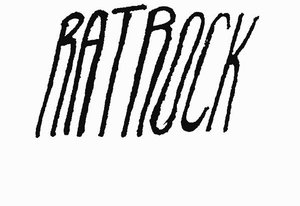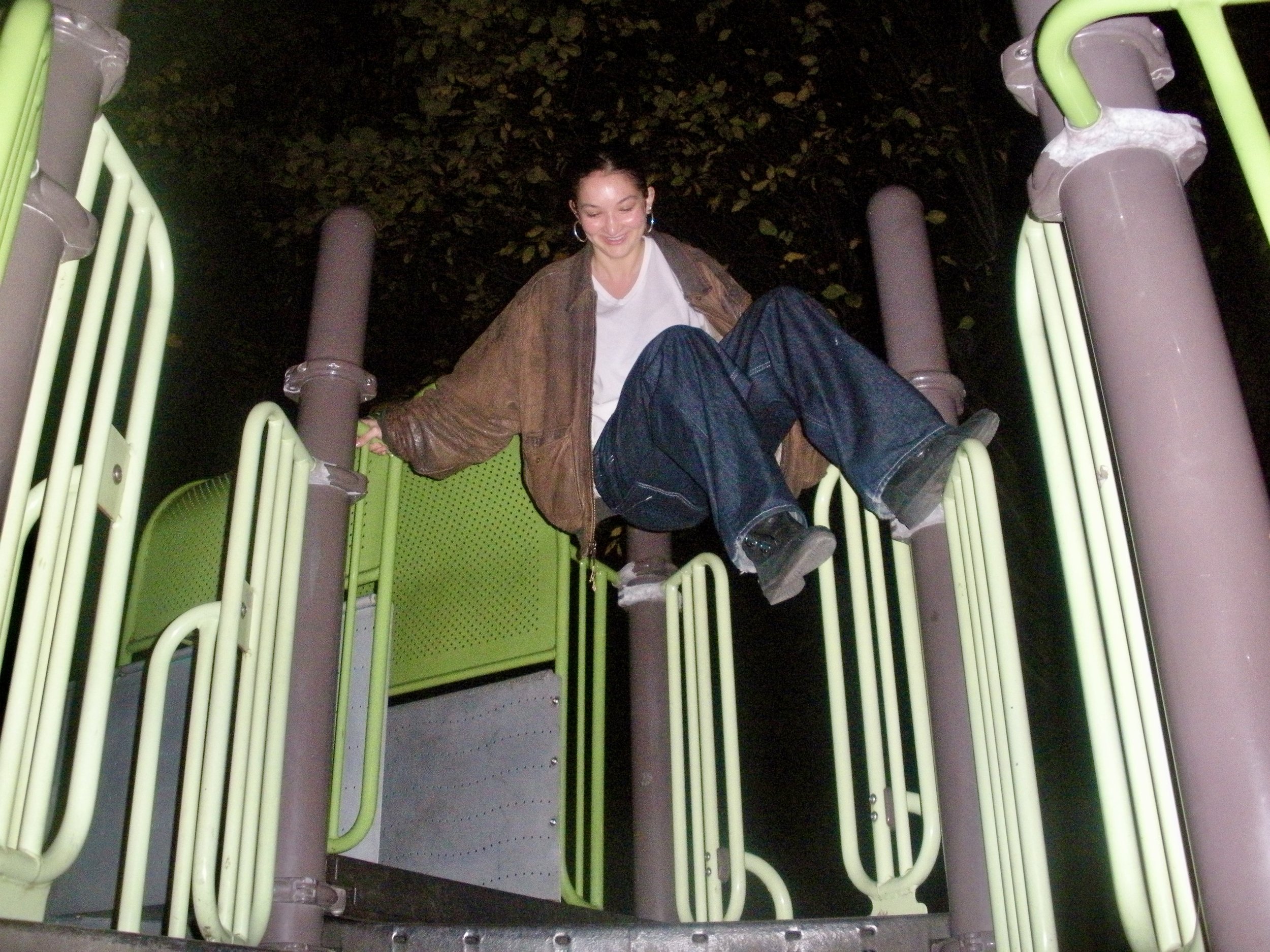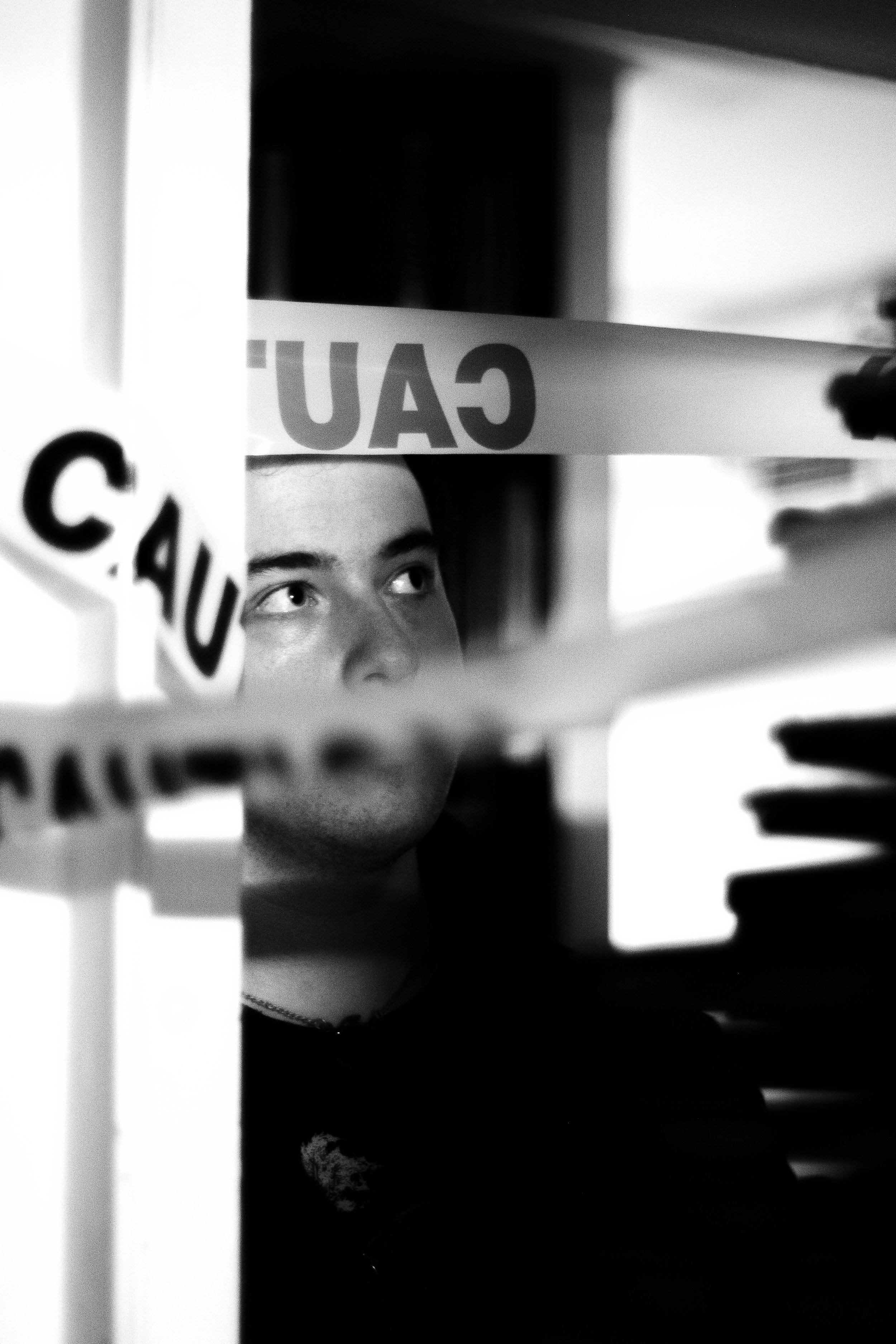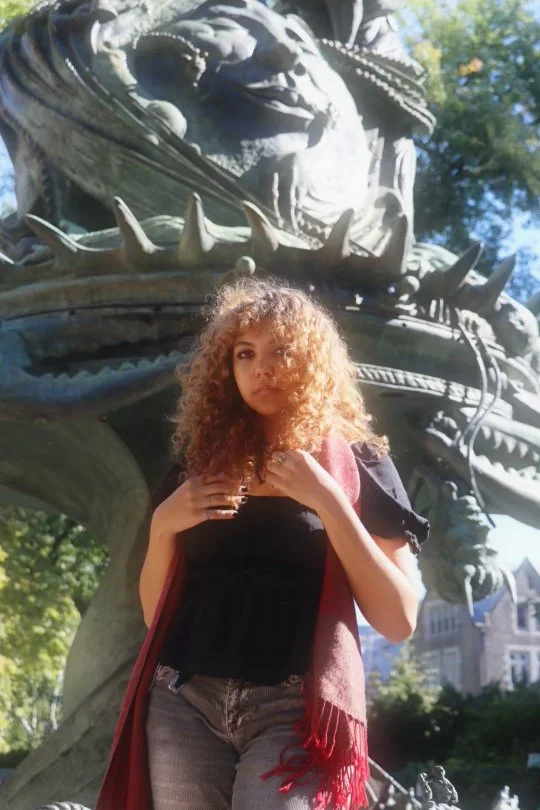Feature by Susana Crane Ruge
Photos by Iris Pope
Phoebe Wagoner is a Senior ‘25 at Columbia College, majoring in American Studies and minoring in Visual Art. She grew up doing all kinds of art- drawing, painting, ceramics- and has settled into making intricate paper cuts.
I called Phoebe my co-parent throughout the summer - and I’m unsure if she knows that. We met as TA’s for a summer program we worked in; we lived together, taking care of high school seniors for around a month. Phoebe and I developed a very caring and somewhat motherly friendship stemming from the caretaking context we were immersed in. When I went over to her suite in EC, she was almost done with cooking me a Mediterranean-inspired meal. “Don’t say I cooked for you, the people will think I’ve gone soft” she said, to which I responded by questioning if she had ever been in a fistfight. Neither of us has. This typical back-and-forth between us concluded with us differentiating ‘boy fights’ through the fact that they were a push– needing to cover a wide area of the opponent's body to signify defeat, and ‘girl fights’, which consist of pulling– of deep scratches and point-and-shoot attacks. Phoebe often comes to very poignant conclusions about simple things by visualizing and conversing through any given topic, ending with a surprisingly eloquent vignette of her thoughts.
Her paper cuts are also concluding vignettes of thoughts, feelings, and experiences that come from “a non-verbal place”. She insists that if she could say what it means with art, she would just say it, and would not need to “make the thing”. Phoebe allows for a free interpretation and interaction with her pieces since others are also encouraged to approach her art from a “non-verbal” place.
House
I asked Phoebe how she began doing art. The story her parents have told her is that, as a baby, the value of a crayon lied in the action of peeling the paper off of it- she would then need a new box of crayons because they were useless without their paper. One day, after visiting the aquarium and having lunch at a fast food restaurant with a kid’s menu and crayons, something clicked in Phoebe’s 1.5-year-old mind, and she had to draw the eels she had just seen. Since then, she never stopped drawing. She used all of her free time during elementary school to draw. Eventually, she attended an art magnet high school in Lexington, Kentucky, and is now pursuing a visual arts minor, along with majoring in American Studies. So Phoebe only knows life through art. She has experienced lulls, dissatisfaction, moments of inspiration, and artistic pivots throughout her childhood, which I find beautiful to follow throughout her pieces.
When Phoebe began at her art high school, she felt like she was ready for the next step: to join the industry and to be a professional artist. She has been an artist since a young age, and, along with the many turning points and defining moments of her early teenage years, she was looking for more. She was trained in all the classical methods of art, for which she is thankful, and she dabbled with ‘being a bad art student’;
“I would start doing protest art- he [her teacher] hated goats and thought they were really creepy- so I only painted goats for an entire year, and he got annoyed at me. I was disrespectful. You know how high school art is like a robot girl saying ‘the system doesn’t define me’ I don’t know, there is such a specific way high schoolers do art, and I got to a point where I wanted that, the strict funnel of still-life, shaded art we had to make, and the ways to rebel against it, to end. Not to discredit my school, I am thankful for learning all I did, and there was space for you to do your own thing, I was just ready to do art my way.”
Eventually, there was a feeling of burnout - ‘I think that is why I didn’t major in it in college’.
onions on a string on your front porch
Listening to Phoebe talk about her non-conformist artistic identity as a teenager, while simultaneously being surrounded by her two stuffed animals, the art on the walls, the warm and welcoming feeling of her room and her ways of making home, I can sense how Phoebe has grown through and with her art as intimately hers. I think that Phoebe’s rebellious years as an artist, the exploration of her own creativity and need for material expression are part of the consistent poise of her pieces. I can confidently say that, even if she feels like it is an overstatement, Phoebe is creatively free.
I asked her what doing art her own way meant. Phoebe doesn’t do much shaded, realistic art anymore, and I wondered how she got into paper cuts, her main artistic medium. She began in high school making colorful, contrasting papercuts- a little more realistic than the ones she makes now. Still, like most of Phoebe, her papercuts are inspired by her farm in Kentucky, her natural and cultural memories, and Appalachian folk songs. She seems to jump from imagery of a rural life she cares so much about, from a timeless place that combines the animated, simple, and imaginative essence of childhood, with the changes and experiences of growing up, and goes from there.
Papercuts sold to raise funds for Eastern Kentucky Mutual Aid
She is glad she stuck with the idea of papercuts, and she has been dedicated to growing within a specific medium. In college, though, as a visual arts student, there is no formal instruction in the medium. So she has a whole base of artwork that has allowed her to experiment with other mediums like clay and sculpture, printmaking, drawing, and painting. Her papercuts have been made independently. I asked Phoebe what the ‘thing’ is that she tries to create with her papercuts. Is it a thematic link? Is it the medium itself? To this, she answered that ‘the goal is to develop a specific visual language in both content and form. Exploring the ways in which the content informs the form, and the form can inform the content.’ Initially, Phoebe didn’t know that traditional Jewish papercuts existed, even though she is now acutely informed by them; her Rabbi's wife gave her a book on Jewish papercuts after she had begun making them of her own accord.
“I had no idea it was a Jewish art form! I was so excited to learn that there was this long history, and I tried to start to be more historically informed about what I was doing, I was learning a lot about how they were doing it. I began copying some of the borders, and now I experiment with my own ideas through this historic Jewish art medium. I like the mirror effect of them.”
Pigs in hat
Some of the traditional paper cuts have writing on them, and even though Phoebe hasn’t written on any of them yet, she has left space, just in case she wants to. When discussing writing in her art, Phoebe showed me her sketchbook from high school. The writing included ‘banana’, ‘big lot’, and a sketch she made for JD Vance, which said ‘JD Vance’. Phoebe’s art is playful. She strikes a balance between technique and play that is truly eloquent and interesting. Each time I take a glance at her pieces, there is another layer, another corner, or another detail to look at- she allows her art to be evergrowing. Phoebe’s art gets bigger, more playful, more serious, it engages with many meanings simultaneously, allowing for a multitude of potential engagements with an audience. She never wants to limit an artistic interpretation by over explaining her work.
“My art is very instinctive. I don’t really know what I am making when I am going in. I’ll have the paper and the pencil, and I’ll play. In terms of content, it’s the first thing that comes to mind- this is partially why I find it hard to describe my art- I don’t think about a meaning before I draw it, I just draw it and then it sort of exists. My TA for one of my classes said something I agree with. There is a way for me to say things I feel intensely about without having to verbalize them, and no one has to know that they were really intense for me, but I know. It’s my own secret. There are references, sometimes, of things that have scarred me, and they are my own little reference. I have moments where I can take back some things by having them in my art, and no one really has to know. I don’t want to have to make some kind of statement, I want it to be both mine and the audiences’ in different and personal ways. It’s more about the individual interaction. I don’t want my art to make only one statement.”
Ceramic yard
Most of Phoebe’s art includes animals, which she has a specific relationship with, growing up on a farm. She told me how her dad would take her out to the barn and kill animals in front of her to desensitize her to it, which both worked and backfired (she was a vegetarian for 10 years). So, Phoebe both personified and attributed personalities to animals, which is clear from her pigs in hats, crocodiles in dresses, and kind of stealthy cats, and is fascinated by “representing the dynamic of animals, those of love but also violence. I have been told that my art is almost childlike, and I do think that it comes from this place of growing up and going through childhood in the farm, and the woods, and the barn.”
Red room
All of these informants that constitute Phoebe’s art make it truly authentic. She provides such genuine art and ways of being that are both refreshing and incredibly complex. She is weird in the sense that she allows herself to express what she needs to without fear, and art will always, I think, be a medium for that. As she comes close to graduating, she has thought about teaching art, or teaching another subject and doing it on the side. She knows that art will always be around and that she will be doing it, to some degree, forever. I see art being so ingrained in her that she might or might not have to pursue it professionally. She does want, however, to get to a point where all of her pieces can be shared or shown. The next step is to figure out a way to share it in a way that is meaningful for her- like local art galleries. Phoebe is, truly, a soft artist. While thinking about teaching as a potential career, she sees creating as a process of intimate creation that is connected to care- she has gone soft, and hopefully will continue to do so.









































